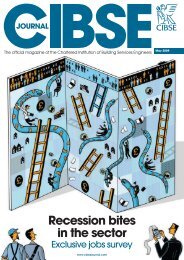Create successful ePaper yourself
Turn your PDF publications into a flip-book with our unique Google optimized e-Paper software.
opinion<br />
Your views from across the built environment<br />
SyStem<br />
change<br />
New directives emerging from Brussels<br />
could transform our approach to system<br />
design, writes Nick Stevenson<br />
It is hard to imagine a more<br />
complex piece of legislation than<br />
the Eco-design of Energy Using<br />
Products directive – or the directive<br />
formerly known <strong>as</strong> the EuP. It h<strong>as</strong> been<br />
the cause of much debate among<br />
manufacturers and design engineers,<br />
and h<strong>as</strong> been held up since 2009,<br />
largely because the detail is so<br />
challenging.<br />
The new law – due to be enacted<br />
this autumn – seeks to impose<br />
environmental controls on every<br />
stage of a product’s development and<br />
operating life. According to European<br />
Commission officials, 80% of a<br />
product’s environmental impact is<br />
determined during its design. Not<br />
only is that hugely challenging, it<br />
fundamentally shifts the priorities of a<br />
building services design engineer.<br />
Traditionally, a project team will<br />
focus on what happens just before<br />
and during activity on site. Products<br />
are specified during the design ph<strong>as</strong>e<br />
and closely monitored when they are<br />
being installed and commissioned.<br />
While thorough, this is not a ‘life-cycle’<br />
approach. Building services engineers<br />
will need to know more about the<br />
design ph<strong>as</strong>e of a piece of equipment,<br />
<strong>as</strong> well <strong>as</strong> what happens to the system<br />
during its operating lifetime.<br />
The Eco-design Directive seeks<br />
to take a cradle-to-grave approach. It<br />
will impose a framework for energy<br />
efficiency standards from the very start<br />
of the design ph<strong>as</strong>e, so that specifiers<br />
have more information about the<br />
equipment they work with. Logically, to<br />
see this process through, the building<br />
services engineering profession<br />
needs to ensure that the products and<br />
systems we specify and design are well<br />
maintained. The directive recognises<br />
this and seeks to ensure that the<br />
energy saving principles established<br />
at the outset are supported through a<br />
product’s entire working life. It also<br />
establishes the principle that building<br />
services products are always supplied<br />
<strong>as</strong> part of a system and, therefore, that<br />
is how they should be evaluated.<br />
The natural twin to this piece of<br />
legislation is, therefore, post-occupancy<br />
evaluation to ensure systems continue<br />
to perform <strong>as</strong> designed. With the<br />
rec<strong>as</strong>ting of the European Performance<br />
of Buildings Directive (EPBD) – also<br />
due later this year – we will see<br />
wider application of Display Energy<br />
Certificates (DECs) that<br />
require regular analysis<br />
of a building’s actual<br />
energy consumption.<br />
This will give us the<br />
opportunity to revisit<br />
our work post-handover<br />
and check that<br />
everything’s in order.<br />
Further planned<br />
changes to the EPBD<br />
include the removal<br />
of the size threshold<br />
so that energy<br />
efficiency improvements will apply<br />
to all buildings; and there will be a<br />
requirement for all public buildings to<br />
prominently display building energy<br />
certificates. The EC hopes the rec<strong>as</strong>t<br />
directive will help to reduce the primary<br />
energy used in Europe by 20% by 2020.<br />
Building services<br />
engineers will<br />
need to know more<br />
about the design<br />
ph<strong>as</strong>e of a piece of<br />
equipment, <strong>as</strong> well<br />
<strong>as</strong> what happens to<br />
the system during its<br />
operating lifetime<br />
In order to meet this target, the<br />
industry needs to fundamentally<br />
change its approach to the design and<br />
use of energy consuming equipment.<br />
Product manufacturers have achieved<br />
a great deal through fine-tuning the<br />
energy performance of individual<br />
products, but more can and is being<br />
done to address the carbon footprint of<br />
whole system design.<br />
With one building needing to be<br />
refurbished every minute between<br />
now and 2050 to reach our energy and<br />
carbon reduction targets, we are on the<br />
edge of a profound shift in our markets.<br />
Building services engineers, equipment<br />
suppliers and installers are facing a<br />
deluge of new me<strong>as</strong>ures all aimed at<br />
directing us towards the ‘cradle-tograve’<br />
and ‘whole-system’ route – we<br />
all need to prepare for them now and<br />
make sure our clients are ready too.<br />
See ‘Regulations’, page 26<br />
l Nick SteveNSoN is new energy director<br />
of Ideal Commercial Heating<br />
www.cibsejournal.com April 2011 <strong>CIBSE</strong> <strong>Journal</strong> 23







